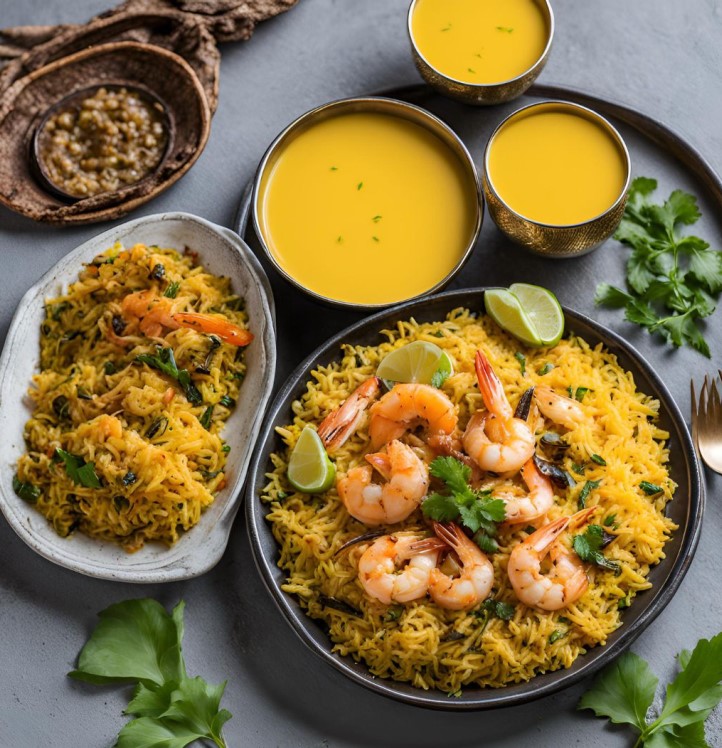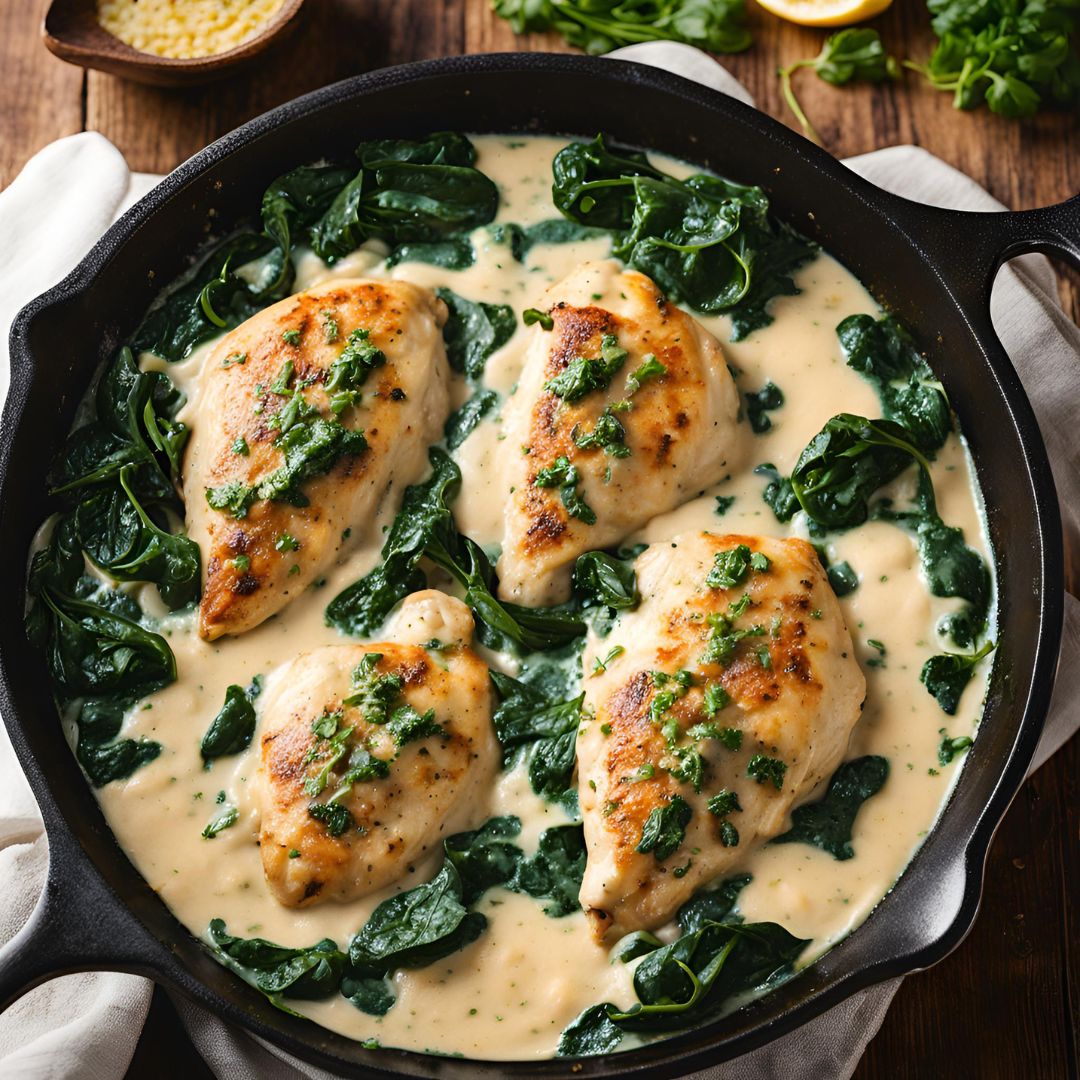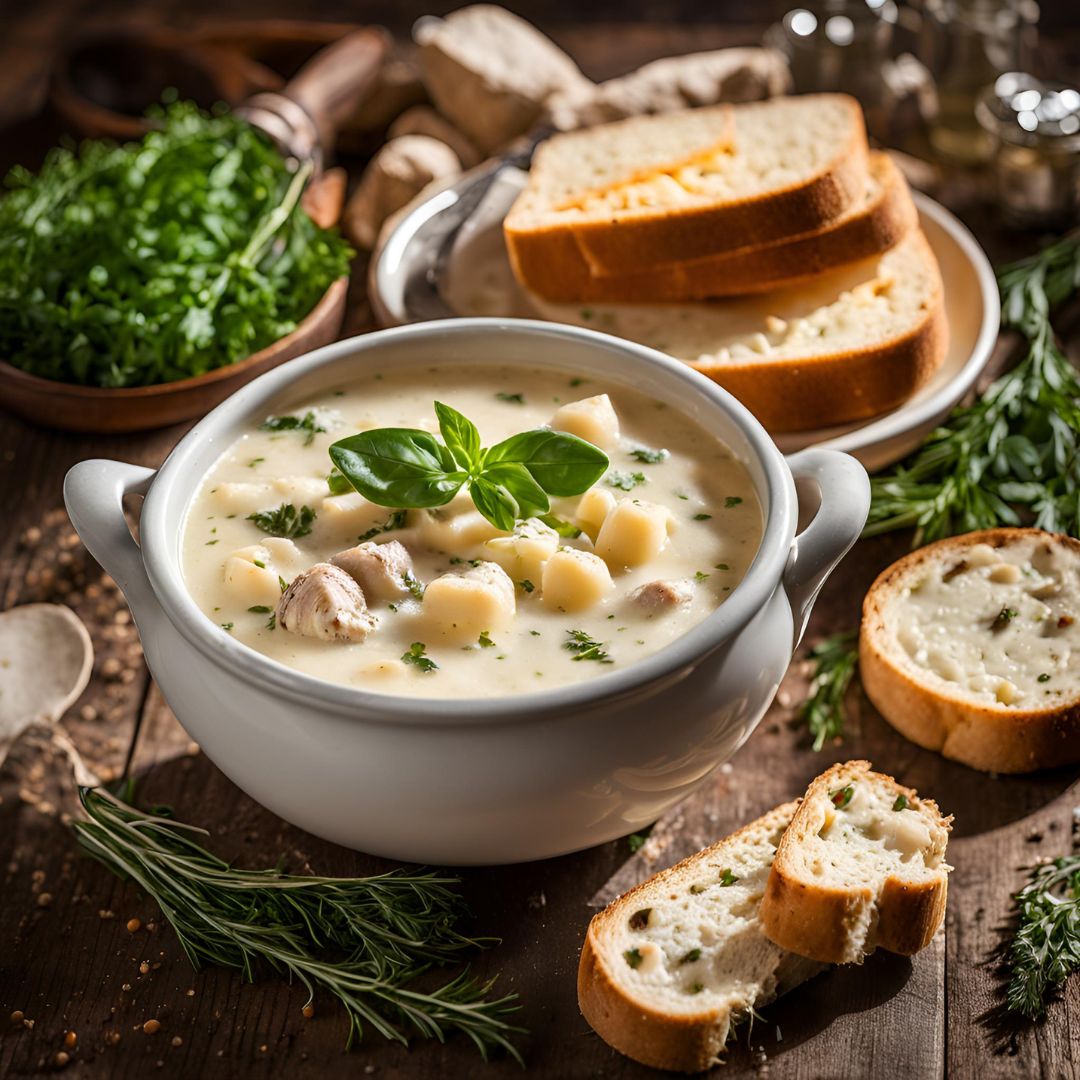Prawn Biryani Recipe – Seafood lover’s delight. Indian cuisine is a tapestry woven with bold flavors, vibrant colors, and aromatic spices, and few dishes embody this essence as magnificently as biryani. Among the myriad variations of this beloved dish, prawn biryani stands out as an exquisite delight that brings together the succulence of seafood with the irresistible allure of fragrant rice. Whether you’re a seasoned cook or a culinary novice, this dish promises a feast for the senses and a dining experience that lingers long after the last morsel has been savored.
Biryani: A Dish Steeped in History
Before diving into the specifics of prawn biryani, it’s essential to understand the historical context of biryani itself. Originating in Persia and brought to the Indian subcontinent by the Mughals, biryani has since evolved into countless regional adaptations, each with its unique character. From the aromatic Hyderabadi biryani to the fiery Kolhapuri biryani and the subtly spiced Lucknowi biryani, the dish has embraced a range of local flavors and ingredients.
The word “biryani” is derived from the Persian term birian, meaning “fried before cooking.” True to its name, the preparation of biryani involves a meticulous layering process where parboiled rice and marinated protein—be it meat, fish, or prawns—are slow-cooked with an assortment of spices. This ensures that every grain of rice and every bite of protein is infused with layers of flavor.
The Allure of Prawn Biryani
What sets prawn biryani apart is its delicate balance of flavors. Prawns, being naturally sweet and tender, pair beautifully with the robust spices typically used in biryani. The juxtaposition of their briny essence with the richness of spiced rice makes this dish a seafood lover’s dream. Moreover, prawns cook quickly, making prawn biryani a comparatively quicker version of the traditional biryani, without compromising on taste or quality.
Prawn biryani is particularly popular in coastal regions of India, where fresh seafood is abundant. States like Kerala, Tamil Nadu, and Goa have their interpretations of this dish, often incorporating coconut milk, tamarind, or regional spices to complement the local palate. Regardless of the regional twist, prawn biryani remains a celebration of the sea, spices, and tradition.
Why Prawn Biryani?
In the bustling world of culinary delights, why should prawn biryani command your attention? Here are a few reasons:
Rich Flavor Profile: Prawn biryani achieves a harmony between the warm, earthy tones of spices like cinnamon, cardamom, and cloves and the fresh, subtle sweetness of prawns. Each ingredient contributes to a symphony of flavors that is as complex as it is satisfying.
Nutritional Benefits: Prawns are an excellent source of lean protein, omega-3 fatty acids, and essential vitamins and minerals like zinc and selenium. Combined with basmati rice, a low-fat carbohydrate, this dish is not just delicious but also nutritious.
Versatility: Whether you’re preparing for a casual family meal or an elaborate dinner party, prawn biryani is an elegant dish that suits every occasion. It can be dressed up with garnishes like fried onions, boiled eggs, and fresh herbs or served simply with raita and papad.
Cultural Fusion: With its roots in Mughal cooking techniques and the incorporation of local ingredients, prawn biryani is a beautiful reflection of India’s culinary diversity. Preparing and sharing this dish allows one to partake in a time-honored tradition that transcends cultural boundaries.
The Anatomy of a Perfect Prawn Biryani
Crafting prawn biryani is an art form that requires attention to detail and respect for each component. The following elements are key to achieving the perfect dish:
The Rice: Long-grain basmati rice is the cornerstone of any biryani. Known for its distinct aroma and non-sticky texture, basmati rice absorbs the flavors of the spices without losing its integrity. The rice is typically parboiled and layered with the prawns during the cooking process.
The Prawns: Fresh, medium-sized prawns are ideal for this recipe. They should be deveined and marinated to ensure maximum flavor absorption. The marinade often includes yogurt, ginger-garlic paste, and a blend of spices like turmeric, chili powder, and garam masala.
The Spices: The hallmark of any biryani is its spice blend. Whole spices like bay leaves, star anise, and cinnamon are used during the cooking process, while powdered spices like cumin and coriander provide depth and complexity.
The Garnishes: Fried onions, fresh coriander leaves, mint, and saffron-infused milk elevate the dish, adding layers of aroma and color.
The Cooking Technique: Traditional biryani is cooked using the “dum” method, where the rice and prawns are layered in a heavy-bottomed pot and sealed with a lid or dough to trap the steam. This slow-cooking technique allows the flavors to meld together beautifully.
A Dish for Every Occasion
One of the reasons biryani, including its prawn variant, holds such a special place in Indian cuisine is its association with celebrations. Whether it’s a wedding, a festival, or a family get-together, biryani is often the star of the menu. Its grandeur and complex flavor profile make it a dish worthy of special occasions, while its versatility allows it to adapt to everyday meals.
For seafood enthusiasts, prawn biryani is a revelation. It combines the satisfying heartiness of traditional biryani with the light, refreshing qualities of seafood. The result is a dish that is indulgent yet not overwhelmingly heavy—a perfect balance of richness and restraint.
Modern Takes on Prawn Biryani
While traditional recipes remain timeless, modern chefs and home cooks have introduced creative twists to prawn biryani. Some add a drizzle of coconut milk for creaminess, while others experiment with quinoa or cauliflower rice for a low-carb alternative. Fusion versions incorporate global flavors like saffron cream or Mediterranean herbs, highlighting the adaptability of this dish.
Conclusion: A Culinary Masterpiece
Prawn biryani is more than just a dish—it’s an experience that brings together the richness of Indian culinary tradition with the delicate flavors of the sea. Its intricate preparation, bold flavors, and undeniable appeal make it a dish worth mastering. Whether you’re new to cooking or a seasoned expert, preparing prawn biryani allows you to explore the depths of flavor and the art of balance that defines Indian cuisine. So gather your ingredients, embrace the aromas of the spice market, and embark on a culinary journey that promises to be as rewarding as it is delicious.
Ingredients for Prawn Biryani Recipe
Items for Marination:
- 500g prawns, cleaned and deveined
- 1/2 cup yogurt
- 1 tablespoon ginger-garlic paste
- 1/2 teaspoon turmeric powder
- 1 teaspoon red chili powder
- 1 teaspoon coriander powder
- 1/2 teaspoon cumin powder
- Salt to taste
For Rice:
- 2 cups Basmati rice, soaked for 30 minutes
- 2-3 green cardamoms
- 1 bay leaf
- 1/2 teaspoon shahi jeera (caraway seeds)
- 1 star Anise
Items for the Biryani:
- 3 tablespoons ghee or oil
- 4-5 cloves
- 2-3 green cardamoms
- 1 bay leaf
- 1 cinnamon stick
- 1/2 teaspoon shahi jeera (caraway seeds)
- 1 star Anise
- 2 large onions, thinly sliced
- 2 green chilies, slit
- 1 large tomato, chopped
- 1/4 cup chopped mint leaves
- 1/4 cup chopped coriander leaves
- 1/4 teaspoon saffron soaked in 2 tablespoons warm milk
- 1 tablespoon lemon juice
- Salt to taste
For Garnish:
- Fried onions (Birista)
- Fresh mint and coriander leaves
Cooking Instructions – Prawn Biryani Recipe
1. Marinate the Prawns:
- In a large mixing bowl, combine the prawns with yogurt, ginger-garlic paste, turmeric powder, red chili powder, coriander powder, cumin powder, and salt.
- Mix well to coat the prawns evenly with the marinade.
- Cover and marinate for 30 minutes.
2. Cook the Rice:
- Wash the Basmati rice thoroughly and soak it for 30 minutes.
- In a large pot, bring 6-7 cups of water to a boil. Add cardamoms, bay leaf, shahi jeera, star anise and salt
- Add the soaked rice and cook until the rice is 70-80% done (it should still be slightly firm).
- Drain the rice and set it aside.
3. Prepare the Prawn Masala:
- Heat ghee or oil in a large, heavy-bottomed pan.
- Add cloves, cardamoms, bay leaf, cinnamon stick, shahi jeera, star anise and saute untill aromas are released.
- Add the sliced onions and sauté until golden brown.
- Add the green chilies and chopped tomatoes, and cook until the tomatoes soften and the oil begins to separate.
- Add the marinated prawns to the pan and cook on medium heat for 5-7 minutes until the prawns are just cooked through. Be careful not to overcook the prawns, as they can become tough.
- Stir in the chopped mint and coriander leaves. Cook for another 2 minutes.
- Squeeze in the lemon juice and mix well.
4. Layer the Biryani:
- In a heavy-bottomed pot or handi, start by spreading a layer of the cooked prawn masala at the bottom.
- Add a layer of the partially cooked rice over the prawns.
- Drizzle some of the saffron milk over the rice and sprinkle some fried onions.
- Repeat the layers if needed, finishing with a top layer of rice.
- Garnish with the remaining saffron milk, fried onions, and fresh herbs.
5. Dum Cooking (Sealing the Pot):
- Seal the pot with a tight-fitting lid or cover it with aluminum foil.
- Cook on very low heat for about 15-20 minutes, allowing the flavors to meld together.
6. Serve:
- Once done, let the biryani rest for 5-10 minutes before serving.
- Gently fluff the rice with a fork and serve hot.
- Garnish with additional fried onions, fresh mint, and coriander leaves.
Serve your Prawn Biryani with a side of raita, papad, and a squeeze of lemon for an extra zing. This biryani is perfect for seafood lovers, offering a delectable balance of flavors and textures in every bite. Enjoy!
Essential Cooking Tips for Prawn Biryani Recipe
1. Use Fresh, High-Quality Prawns
Fresh prawns are the star of prawn biryani, so it’s important to choose them carefully. Opt for medium to large prawns, as they hold their texture better during cooking. Fresh prawns should have a mild sea-like aroma, firm flesh, and translucent shells. If fresh prawns aren’t available, frozen ones can be used, but ensure they are thawed and patted dry before marinating.
2. Marinate for Maximum Flavor
Marinating prawns is crucial to infuse them with the bold flavors of the spices and herbs. A good marinade typically includes ingredients like yogurt, turmeric, chili powder, ginger-garlic paste, and garam masala. Allow the prawns to marinate for at least 30 minutes but not more than 1 hour, as over-marinating can break down the delicate texture of the prawns.
3. Parboil the Rice to Perfection
The rice in biryani should be parboiled to about 70-80% doneness before being layered with the prawns. Use long-grain basmati rice for its fragrant aroma and non-sticky texture. Parboiling ensures the rice finishes cooking during the “dum” process, absorbing the flavors of the prawns and spices without becoming mushy.
4. Layer Strategically for Even Cooking
The hallmark of biryani lies in its layered construction. Spread a layer of parboiled rice at the bottom of the pot, followed by the marinated prawns, and finish with another layer of rice. Add garnishes like fried onions, saffron-infused milk, and mint between layers for added aroma and richness. This layering technique ensures that each spoonful delivers a balanced mix of rice and prawns.
5. Master the “Dum” Cooking Method
The traditional “dum” method, where the pot is sealed to trap steam, is essential for achieving the authentic biryani texture and flavor. Use a heavy-bottomed pan to prevent burning, and seal the lid with dough or foil to lock in the steam. Cook on low heat to allow the flavors to meld and the rice to finish cooking gently. Place a griddle or tawa under the pot to distribute heat evenly if necessary.
Some More Interesting Recipes –
- Andhra Chicken Biryani Recipe
- Hyderabadi Chicken Biryani Recipe
- Chicken Tikka Masala Recipe
- Butter Chicken Recipe
- Chicken Jalfrezi Recipe
- Mutton Biryani Recipe
- Chettinad Biryani Recipe
- Dal Makhani Recipe
- Aloo Samosa Recipe
- Aloo Capsicum Masala Recipe
- Rajma Masala Recipe
- Pav Bhaji Recipe
- Onion Pakora Recipe
- Chicken Korma Recipe
- Dahi Chicken Recipe
- Malai Kofta Recipe
- Kadai Chicken Recipe
- Mughlai Chicken Recipe
Important FAQs for Prawn Biryani Recipe
1. Can I use frozen prawns for this recipe of Prawn Biryani ?
Yes, you can use frozen prawns if fresh ones are unavailable, but make sure to thaw them completely before using. It’s essential to pat them dry with a paper towel to remove excess moisture, as watery prawns can affect the texture of your biryani. Fresh prawns, however, are preferred for their tenderness and better flavor.
2. How do I prevent prawns from overcooking in the biryani recipe?
Prawns cook very quickly and can become rubbery if overcooked. Sauté prawns briefly before layering them with the rice to ensure they are cooked perfectly. It’s best to cook them for 2-3 minutes until they turn pink, then remove them from the pan. They will cook further during the dum cooking (slow cooking) process, so avoid cooking them too much in the initial stages.
3. How do I clean and devein prawns for this recipe of biryani?
To clean prawns, follow these steps:
Remove the head and shell of the prawns, leaving the tail on (optional).
Devein the prawns by making a shallow cut along the back to expose the dark vein, which is the digestive tract. Remove it carefully using a small knife or toothpick.
Rinse the prawns well under cold water to remove any remaining debris.
4. Can I use other types of seafood in place of prawns for this Biryani Recipe?
Yes, you can substitute prawns with other seafood such as fish (like kingfish or tilapia) or lobster. However, seafood like fish or lobster may require different cooking times, so adjust accordingly. The flavor profile of the biryani will change slightly depending on the type of seafood you choose.
5. Should I marinate the prawns for this biryani recipe?
Yes, marinating prawns is important for enhancing their flavor and tenderness. Marinate the prawns in yogurt, ginger-garlic paste, turmeric, red chili powder, garam masala, and a little lemon juice for at least 30 minutes. This helps infuse the prawns with the spices and tenderizes the meat, making the biryani more flavorful.
6. How do I ensure my rice and prawns are cooked perfectly together in this Biryani Recipe?
To make sure the rice and prawns cook evenly in the biryani:
Partially cook the rice before layering it with the prawns. The rice should be about 70-80% cooked, so it can absorb the flavors during the dum cooking process without becoming mushy.
Layer the prawns and rice carefully. The prawns should be placed in the middle of the rice, not on top, to ensure they cook evenly during the final dum stage.
Avoid over-layering. Too many layers can prevent even cooking, so it’s best to keep it simple with a few layers.
7. What spices are used for Prawn Biryani Recipe generally ?
The spices used in prawn biryani are similar to those used in traditional mutton or chicken biryani but often with a slightly lighter touch, to complement the delicate flavor of prawns. Some essential spices include:
Cumin (whole and ground)
Coriander powder
Cardamom pods
Cloves
Cinnamon stick
Bay leaves
Garam masala
Red chili powder
Saffron (optional, for fragrance and color)
Fresh mint and coriander leaves (for garnish)
8. Can I make prawn biryani ahead of time following this recipe?
Yes, prawn biryani can be made ahead of time. In fact, it often tastes better after the flavors have had time to meld together. To do so:
- Prepare the biryani up to the layering stage, then cover it and refrigerate it for several hours or overnight.
- When ready to serve, reheat it gently on low heat, either on the stovetop or in the oven (cover with foil to prevent the rice from drying out).
- Add a little extra ghee or water when reheating to keep the rice moist.
9. How do I get the biryani to have the perfect texture?
The perfect prawn biryani should have fluffy rice and tender prawns without being too greasy or dry. To achieve this:
- Use quality basmati rice and rinse it thoroughly before cooking to remove excess starch.
- Cook the rice until it’s 70-80% done. Do not overcook the rice initially, as it will cook further during the dum cooking.
- Add enough ghee (or butter) during layering to ensure the rice is fragrant and moist.
- Cook on low heat for the final dum stage to prevent burning and allow the flavors to infuse.
10. Can I make prawn biryani without saffron following this recipe?
Yes, saffron is optional in prawn biryani, although it adds a beautiful color and fragrance. If you don’t have saffron, you can use a pinch of turmeric for color, or simply skip it. For added aroma, you can use rose water or kewra water in place of saffron, or add a few drops while layering the rice to enhance the fragrance of the biryani.
Prawn Biryani Recipe

Ingredients for Prawn Biryani Recipe
Items for Marination:
For Rice:
For Garnish:
Cooking Instructions - Prawn Biryani Recipe
1. Marinate the Prawns:
- • In a large mixing bowl, combine the prawns with yogurt, ginger-garlic paste, turmeric powder, red chili powder, coriander powder, cumin powder, and salt.
- • Mix well to coat the prawns evenly with the marinade.
- • Cover and marinate for 30 minutes.
2. Cook the Rice:
- • Wash the Basmati rice thoroughly and soak it for 30 minutes.
- • In a large pot, bring 6-7 cups of water to a boil. Add cardamoms, bay leaf, shahi jeera, star anise and salt
- • Add the soaked rice and cook until the rice is 70-80% done (it should still be slightly firm).
- • Drain the rice and set it aside.
3. Prepare the Prawn Masala:
- • Heat ghee or oil in a large, heavy-bottomed pan.
- • Add cloves, cardamoms, bay leaf, cinnamon stick, shahi jeera, star anise and saute untill aromas are released.
- • Add the sliced onions and sauté until golden brown.
- • Add the green chilies and chopped tomatoes, and cook until the tomatoes soften and the oil begins to separate.
- • Add the marinated prawns to the pan and cook on medium heat for 5-7 minutes until the prawns are just cooked through. Be careful not to overcook the prawns, as they can become tough.
- • Stir in the chopped mint and coriander leaves. Cook for another 2 minutes.
- • Squeeze in the lemon juice and mix well.
4. Layer the Biryani:
- • In a heavy-bottomed pot or handi, start by spreading a layer of the cooked prawn masala at the bottom.
- • Add a layer of the partially cooked rice over the prawns.
- • Drizzle some of the saffron milk over the rice and sprinkle some fried onions.
- • Repeat the layers if needed, finishing with a top layer of rice.
- • Garnish with the remaining saffron milk, fried onions, and fresh herbs.
5. Dum Cooking (Sealing the Pot):
- • Seal the pot with a tight-fitting lid or cover it with aluminum foil.
- • Cook on very low heat for about 15-20 minutes, allowing the flavors to meld together.
6. Serve:
- • Once done, let the biryani rest for 5-10 minutes before serving.
- • Gently fluff the rice with a fork and serve hot.
- • Garnish with additional fried onions, fresh mint, and coriander leaves.





